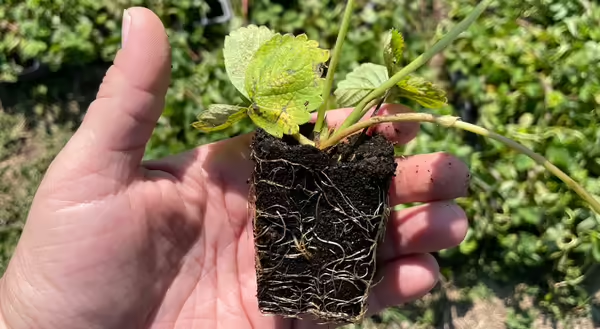
It’s here and now we have to deal with it. Neopestalotiopsis fruit rot and leaf spot of strawberry, caused by a previously unknown, more aggressive Neopestalotiopsis species, was first reported to cause significant damage in Florida strawberry fields in 2019, and has since been reported throughout much of the Southeast, Northeast and parts of the Midwest, including Illinois. Growers can read Penn State’s Strawberry Disease Identification: Neopestalotiopsis (aka Pestalotia) or a More Traditional Disease? to better understand and recognize the subtle differences in symptomology between this and other strawberry diseases.
Though we are in the early stages of understanding this disease, some data is available on cultivar susceptibility, including Purdue’s Strawberry Cultivar Susceptibility to Neopestalotiopsis Leaf Spot in Indiana. Beyond cultivar sensitivity, source and type of planting material plays a huge role in the development of this disease. Bare-root strawberry plants are used as planting materials in the matted-row system, whereas plug plants are typically used in the plasticulture system in Illinois. Although this disease can infect any susceptible strawberry, it is much more prevalent on strawberries from plant material that started as a tip cutting, then grown out to plug plants for plasticulture production.
The life cycle of this disease is not well understood yet, but water seems to be the driving force behind the spread of this disease. The process of growing a plug plant from a tip uses a lot more water than bare root plant production and may explain why this disease to date is not as prevalent in bare root plant material. Plug production starts with an unrooted strawberry tip cutting, and this is where the problem can start. The tip can appear to be “clean” (asymptomatic), yet still be infected with disease inoculum. As soon as the tips are planted in trays and placed under mist to prevent wilting until rooting occurs, conditions are conducive for primary infection because of the mist system (free water). As with tips, even after culling trays with obvious signs of disease, some plants may be asymptomatic and make it to a field planting where it is not uncommon to set up overhead irrigation immediately after planting…again providing the water needed for disease spread. So where does this leave growers who have strawberries in the ground now?
Once strawberries are planted, a preventative fall fungicide spray program is recommended with thiram as the backbone fungicide. For links to Dr. Dan Egel’s fungicide trials and further notes on the disease from Wenjing Guan, visit Purdue University Facts for Fancy Fruit Strawberry Growers: Navigating the Challenges of Neopestalotiopsis Disease. In addition to a protectant fungicide program, avoid handling plants when wet, and practice sanitation of worker's hands, clothing, boots and tools. Removing infected plants, including their crowns and roots, from the field helps reduce the amount of infected plant debris that could otherwise persist and serve as a potential source of infection in the following year.
Another issue that needs to be addressed is the potential to harbor and carry over inoculum from previous years’ crops on the row covers. Row covers are reused for multiple seasons to stimulate growth and provide winter and frost protection, and the question is how to sanitize the row covers to reduce potential infection. We may already have conditions suitable for harnessing our summer heat to kill inoculum clinging to the covers. Imagine putting the covers in a sealed metal container and allowing it to heat up over the summer, much like the inside of a car on a hot day with the windows rolled up. What needs to be determined is how hot does it need to reach and for how long, then we need to determine field methodology to achieve this…how hot does it get all the way to the center mass of covers and for how long in a particular container. Another potential avenue is treating covers with a quaternary ammonium product, then drying ahead of storage. Stay tuned as we work towards a workable solution.